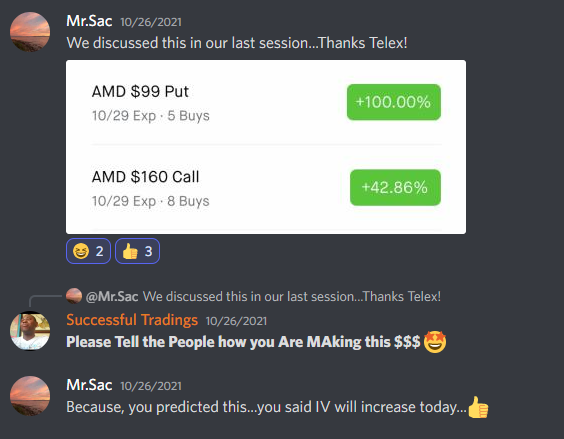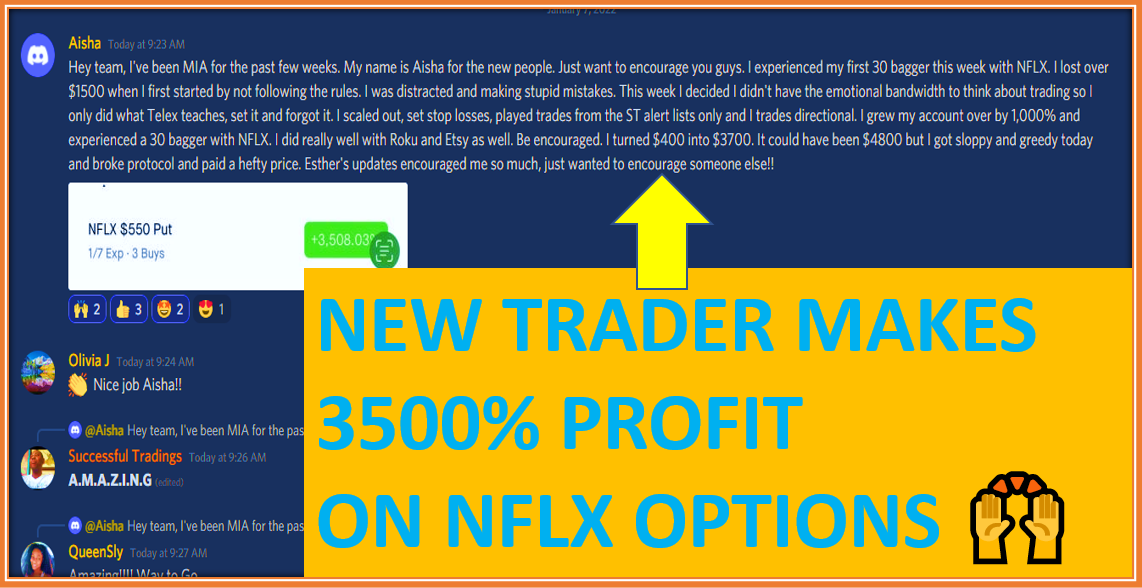Options markets conditions have never been as volatile as in the last couple of years.
Many traders find themselves struggling with Implied Volatility (IV) Crush that eat up options premium faster than you can imagine.
In this IV Crush tutorial, I will bring you all the insights you need to successfully trade IV crush as well as my secret IV Crush to keep your options trading account from crashing.
Table of Contents
What does IV Crush mean in stocks Options
To first step in understanding Implied Volatility Crush or IV Crush is to define what Implied volatility itself is.
Implied Volatility in Options trading measures the “probability” of a move on the underlying stock.
This “probability” can go well above 100% and does not have a limit on how high it can go.
If a stock is likely to make a big move, then the Implied volatility of its options will be higher.
What is IV Crush in Options Trading
As an example, a 2% move on a stock can yield IV of 50%.
If the same stock is expected to move 10% due to an upcoming event, then the IV can jump to 150%.
We can call this increase an Implied Volatility spike (IV Spike).
It does not matter if that forecasted big movement on the stock is on the downside or on the upside.
Consequently, IV Crush applies to both calls and puts alike.
Now that we know what IV is, IV Crush means the opposite of Implied Volatility spike.
IV Crush denotes a severe reduction in the IV number of an option.
This phenomenon has very negative consequences for options buyers if they are not well prepared to handle the sudden reduction in Implied Volatility.

Here is my recent YouTube video depicting IV Crush after Earnings on TSLA stock.
What Triggers Implied Volatility Crush
The most important aspect of an IV crush is the fact that in order to have an Implied Volatility Crush, there must first be an Implied Volatility spike.
This makes sense because in order for this IV metric to come down (to be reduced or crushed), it suggests that it has previously gone up.
Events that Make Implied Volatility go Up and then Crush
- Any Unexpected news on a stock will make the Implied Volatility go up. That news can be positive or negative.
- Quarterly Earnings – Earnings are the most obvious events that create IV Spike and thus IV crush
- Upgrades/Downgrades – Rating by stocks Analysts create Volatility spikes because they are totally random and create unexpected move on the affected stocks
- Buyout Rumors – There is nothing more extreme than a buyout or merger and acquisition to send the price of a stock “to the moon” or to the ground for the acquiring company.
How Does Implied Volatility Affect Options Price?
Implied Volatility has a strong correlation with options price.
It works as follows.
When IV goes up, the option price goes up.
If IV decreases and all things being constant, the price of the option will decrease.
#Video Illustration of IV Crush after Earnings for NFLX Stock in July 2022.
Why implied Volatility is important?
Implied volatility is important for Options traders to understand when they are buying/trading an overpriced option.
You can leverage this knowledge of cheap or overpriced options to either buy or sell to open a position.
The IV volatility option strategy is a very smart way to make money trading options.
How Do You Trade Earnings with Implied Volatility Crush?
The majority of stocks (98% at least) will experience Implied Volatility Crush after Earnings.
It just depends on the severity of the so-called IV Crush.
Some tend to be bigger than others.
The rule of thumb for me is not to trade any option with Implied Volatility greater than 100% leading into Earnings.
The probability is not on the side of options buyers in this scenario.
Instead, here is my strategy to trade Earnings with High IV Crush.
Options writers on the other hand have a greater probability (over 70% chance of winning).
Take Advantage of IV Crush by becoming a Market Maker
So, why don’t all traders sell options before Earnings i.e. become market makers?
Answer: A trader needs a certain amount of money or leverage to become an option writer because of the potential risks.
A $25,000 account will give you enough leverage (2X to 4X) in order to become a market maker.
The drawback of writing options is that you can lose more money than what someone who buys options.
An option buyer can only lose as much as they invest in.
What stocks have the highest IV?
In recent times, the most volatile stocks have been the meme stocks lead by the following stocks in the table below:
| GME Stock | AMC Stock | RDBX Stock |
| COIN STOCK | DASH Stock | TSLA Stock |
| AMZN Stock | SQ Stock | OXY Stock |
People Also ask FAQS
How do you stop an IV Crush?
There is nothing that can help traders stop IV crush other than not falling for it by not taking trade with high IV to start with.
In that sense, you will prevent IV Crush by either becoming the market maker that sell high prices options to traders who will fall victim to IV Crush.
Otherwise, just stay on the sidelines and wait until IV comes back down or trade a stock that does not show high IV spike (below 50% is always a good IV).
How does IV Crush affect Puts?
IV Crush affect both Calls and Puts equally.
I am not sure who told options traders that IV only has an impact on Puts.
Granted, you may see a slightly bigger IV numbers on the puts side, but calls are just as likely to be impacted by the IV Crush.
How does IV Crush benefit you?
Implied Volatility Crush (IV Crush) benefit you if you are an options seller.
Because you would sell options to buyers when IV is high then you will close your positions after the IV Crush has taken effect.
How do you know if you have an IV Crush?
The setup for an implied volatility Crush is first a spike in the Implied volatility.
This is detected by reading the IV chart and determining if the Implied Volatility change (%) is greater than 10%.
If so, then compare the current Implied Volatility to its 30-day average.
You should see that the current Implied Volatility is much higher than the 30-day average.
Here is a good Example of IV crush setup on AAPL before its July28 , 2022 Earnings.

A few hours before AAPL Earnings on July 28, 2022, the current Implied Volatility on the Top Diagram is at 79% while the 30-day average is much lower at 44%.
furthermore, the Implied Volatility change percentage (%) for that day is +12% which means that all things being equal, the price of the options leading to the after-hours Earnings release have gone up significantly.
This is how you determine if you have a potential IV Crush post Earnings.
How do you make money from Earnings IV Crush?
Option Sellers are the ones who make money from Earnings IV Crush.
Options Buyers have a high probability of losing money on Earnings IV Crush.
What Happens after IV Crush?
After IV Crush, the price of Options even the ones in the money come down significantly and thus contract holders after IV Crush will lose money.
How do you trade earnings with IV Crush?
You scalp before the Earnings.
Then you wait after the Earnings to Day Trade whatever Momentum the stock has.
You Can use my Gangsta Day Trade Strategy after Earnings to avoid Earnings IV Crush.
Is Low Implied Volatility Good?
Low IV is good for options buyers because they can get into cheap option contracts in hope to close them later at a much higher price.
Is High Implied Volatility Good or Bad?
High Implied Volatility is good for option sellers and bad for options buyers in general.
This is because the option sellers get to cash high premiums when IV is high and they can close their positions by buying back those contracts at a much cheaper prices when IV is lower.
Is High IV good for Options?
No, high V is not good for options buyers.
High IV make options become overpriced.
It is good for Options sellers who can sell at a higher price.
Does IV Crush affect Leaps?
Leap Options which are longer term expiration Options are not often affected by the IV crush.
Closer expiration dates are the ones with the bigger impact form IV crush.
Weekly options react the most to IV crush.
Followed by bi-weekly options to certain extend.
Therefore, if you really want to shield your positions from IV crush, you should consider 1-month away expiration date.
The drawback is that it will cost you more money to buy those further away contracts.
What Is a good Implied Volatility?
A good Implied volatility is the one that has not soared and is very close to the 30-dayy average.
Typically, An IV below 50% is considered to be good for most stocks.
For ETFs such as SPY or QQQ, a good IV Volatility is below 20%
How quickly does IV drop after Earnings?
We showed on the NFLX post Earnings IV crush that the IV goes down within the first five (5) minutes of the trading session.
Watch the NFLX video above to see the details.
What makes IV go up?
Markets makers decide when IV goes up based on the stock price and the volume of contracts being traded on a given stock.
If more traders are buying a given contract strike price, the IV will go up.
Similarly, if a stock is moving fast or is likely to make a big move, IV will go up as well.
The reverse is also true: For stock that go sideways, the IV will decrease.
Why is IV High before Earnings?
IV is high before Earnings before traders are anticipating that the announcement of quarterly Earnings results will generate a big movement on the stock price.
Markets makers take advantage of this anticipation to increase the IV thus increasing the price of options premium.
The stock can make a big move after Earnings release.
However, if the real move is lower than the expected move, then even if a trader has the right direction (calls or puts), they may still lose a lot of money because of the IV crush.
How does IV affect options price?
The options price goes up when IV rise and come down when IV reduces.
I have seen many instances when options traders make money on calls when the underlying stock goes down simply due to the IV spike.
And the opposite is true as well.
AMD Earnings: Trader makes money on both the calls and puts simultaneously.

What does it mean to be IV crushed?
You are IV crushed when you buy options when the IV is elevated (spike) and then later on IV significantly reduces.
You will lose money in this scenario.
The perfect illustration is on Earnings where IV Crush is the most prominent.
What does 0% Implied Volatility mean?
I have never seen a zero percent Implied Volatility in Options.
Single digit yes.
On ETF like SPY and QQQ before the markets started running crazy with inflation talk.
Does IV go up after Earnings?
No, Implied Volatility typically goes down after Earnings.
In rare cases where there was no expected big move, then yeah IV will go up IF there was an Earnings surprise.
This means that the stock made a bigger move than expected.
In such scenario, there would not be a IV spike before Earnings.
How Is High Implied Volatility Profitable?
High Implied volatility is profitable for market makers i.e., people who sell options because they sell them at a higher price when IV is high.
After the IV crush take effect, those options sellers can close their positions at a lower price and pocket the difference as a profit.
Is 60% Implied Volatility High ?
60% IV is not bad by itself assuming that it has not spiked to setup an IV Crush around an upcoming event.
Standard stocks tend to have their Implied volatility between 50 and 90%.
The more the stock is likely to move, the higher its Implied volatility is.
There is a clear correlation linear between Implied Volatility and ATR.
How do you Profit from Volatility?
As an options buyer, you profit from IV by buying when IV is low and selling (closing your position) when IV is high.
The perfect example of this is the day of Earnings for a stock.
As the closing of the session nears, IV increases and you will benefit from this at a high probability.
The opposite way to benefit from IV Volatility is to sell options to open your position.
However, this IV strategy can be risky when there is no IV crush and the stock end up making a surprise bigger move.
What does IV of 100% mean?
An Implied Volatility value of 100% is elevated.
However, if the long-term average Implied volatility of an option is 150% (GME or AMC for instance), the value of 100% does not seem that high at all.
Does Implied Volatility change Daily?
Yes, the Implied Volatility changes constantly as the stock price and options price are moving throughout the daily trading session.
Market makers have the ability to change Implied volatility based on the fluctuations of the stock price and the volume of options traders are buying and selling.
What is Implied volatility 30?
Implied Volatility of 30 is a good IV.
It means that the cost of the option is reasonable.
All things being equal, a trader needs to pick an option with an Implied volatility as low as possible.
What Delta is good in Options?
You should think of Delta as the probability of the option contract for being In the Money t Expiration.
Therefore, the bigger the Delta (in absolute value) the better but higher Delta options are more expensive.
The best way to select the Delta is to use a ratio of Delta over Theta.
The bigger this ratio is the higher the probability of making some good money.
Many traders will argue at least a 20% Delta is needed.
As for me, I have had a great run trading 0% Delta Options for many years albeit with stocks from my AI Trading system.
How do you read Implied Volatility Chart?
Here is an easy YouTube video that explains step-by-step how to read an Implied Volatility chart.
How do you know if an option is overpriced?
An option is overpriced when the Implied volatility has gone up.
You can use the Implied Volatility change % to figure out when an option is overpriced.
Implied Volatility change % should not be greater than 5%.
When an option is overpriced, you will see that the IV change% goes above 10%.
How much will IV Change after Earnings?
Typically, IV will reduce after Earnings.
I have seen instances on high flying stocks like Tesla, NVDA, NFLX where IV Crush was a much as -50%.
Thus, it makes it very difficult to benefit from a winning trade.
What is a good Implied Volatility percentage?
The IV constellation provides a chart of Implied volatility history.
A trader should consider a good Implied volatility percentage based on the historical numbers.
now, if you have two trades to compare with different IV, then you pick the one with the lowest values for sure if buying options.
A great Implied Volatility percentage will be below 20% for a stock.
However, it is important to note that the reason a stock options has low Implied volatility is because the likelihood of it moving is not that high.
Can you sell a call option before it hits the strike price?
Yes, you can sell (close your position) a call option well before it hits the strike price.
why?
When you reach your profit target will be a good reason.
You can be making 100%, 200% well before your call option hits the strike price.
Another scenario is if the trade hits your stop loss limit.
Let’s say you spend $100 on August 19 50 Calls when the stock is trading at $49.
If the stock starts going down towards $48, you will be losing money.
If you have decided that you do not want to lose more than 30% of that investment, you will find yourself selling your Call option well before it hits the strike price.
What is IV Crush?
IV Crush read Implied Volatility Crush is when the IV of options is decreased following a spike so that market makers (option writers) can take big profit from the sale of high price premium.
FINAL THOUGTS ON IV CRUSH
Implied Volatility Crush (IV Crush) is a big snare for option buyers.
One must know how to navigate around this in order to avoid IV Crush which lead to big losses.
Hopefully, we shared very simple trading strategies on how you can take advantage of IV Crush.

Hold a Master Degree in Electrical engineering from Texas A&M University.
African born – French Raised and US matured who speak 5 languages.
Active Stock Options Trader and Coach since 2014.
Most Swing Trade weekly Options and Specialize in 10-Baggers !
YouTube Channel: https://www.youtube.com/c/SuccessfulTradings
Other Website: https://237answersblog.com/
